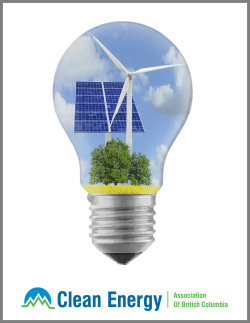Currency Electrification of the BC power grid
By Anna Guy
The heat wave that hit BC in July, 2018 broke more that just temperature records—the record for summer power consumption in BC was also broken when the hourly demand reached more than 7,800 megawatts.
BC Hydro described the event as “a continuation of a trend of higher demand…as a result in climate change.” Reports like this have promoted energy producers to have a good hard look at how they can meet energy demands while still keeping an eye on meeting carbon reduction targets.
B.C. has the advantage of carbon-free, renewable energy resources and is particularly well-suited for clean electrification in particular, an energy source that is the potential solution to reducing GHG levels and reaching BC’s carbon-free targets. In fact, electrification offers the province a critical competitive advantage in the global pursuit of clean growth. After all, the province boasts one of the lowest-carbon electricity grids in North America.
As the voice for renewable energy in the province, Clean Energy BC counts over 125 private sectors and First Nations involved in delivering clean, environmentally responsible electricity to British Columbians, and is spearheading a plan to help BC on track for carbon emission reductions.
In October, 2018, Clean Energy BC released the “Electrification of British Columbia” white paper. The paper clearly outlined that B.C. will not reach its carbon reduction emissions targets if the status quo continues—especially with the addition of LNG Canada’s decision to move ahead with the $40 billion project. By 2050, B.C.’s goal is to reduce carbon emissions from current levels of 62.9 Mt a year to just 13 Mt. According to Clean Energy BC, this can be achieved with clean, renewable electricity.
Jae Mather, Executive Director of Clean Energy BC, calculates the province will require about 50 per cent more electricity production than it has now to meet demand in 2030. Clean Energy BC’s message distilled is this: a huge amount of new power will be needed in order to both support the LNG sector and meet carbon targets.
Clean Energy BC takes a macro view of energy needs. It’s one thing to say an LNG plant will reduce carbon emissions overseas, and it’s another to account for the energy that goes into transportation, distribution, and upstream of the product. Without factoring those things in, no real headway will be made in GHG reduction.
“If the LNG can reduce the carbon emission by 50 per cent but does not consider upstream and transportation, it only ends up being 18 per cent in aggregate reduction,” says Mather. “We need to increase electricity production by 50 per cent by 2030 and 100 per cent by 2050.”
“That is great deal of power, especially with the new LNG industry which is taking shape in BC. If we don’t electrify this industry, it will effectively become impossible to meet our bigger 2050 goals in carbon reduction.”
Clean Energy BC’s position is that “electrification is the only major current solution,” says Mather. “BC Hydro and the BC Utility Commission’s plans are disjoined because they do not take climate change policy into detailed account.” This is a big part of the reason why the load growth predictions for the province are still fairly low. However, change has already begun.
For one thing, BC is particularly well-suited for clean electrification, and has one of the lowest-carbon electricity grids in North America. “There has never been a better time for low-cost, private-sector clean energy power producers to ensure that the province delivers on its climate change commitments,” Mather says. “At this vital time the clean energy sector can be utilized as a core tool to enable BC to raise up and meet these challenges head-on.”
Opportunity for Increased Electrification
The numbers detailed in the White Paper were even surprising to the clean energy industry, but they feel that information and instruction are tools to help the government, the private sector, and Indigenous communities work cohesively toward a clear goal.
“The province’s independent private sector power producers are ideally positioned to deliver the infrastructure needed to provide this electricity; including that needed to electrify the natural gas sector and proposed LNG industry,” say Mather. “These companies build projects for 25 to 40-year lifespans. Their contributions will ensure British Columbia delivers on its greenhouse gas reduction commitments. Its power generation sector can responsibly and cost- effectively provide the additional renewable electricity that extensive electrification will require.”
As much fiduciary and environmental sense as this plan makes, we cannot act like it is optional, Mather warns. “The cost that climate change is going to unleash on our country are far in excess of anything any industry in our country could ever make in profit. Our relationship with energy has changed and changed forever. We can not afford to miss this opportunity!”
Another impetus for electrification is it overrides economic barriers imposed by companies whose regulations dictate that their partners’ environmental standards align with theirs. Not transitioning to clean energy sources may make it very difficult for companies to operate with places non-compliant with international climate agreements.
Clean Energy BC has laid the foundation. It’s now time for action. “There has never been a better time for low-cost, private-sector clean energy power producers to ensure that the province delivers on its climate change commitments,” says Mather. “At this vital time the clean energy sector can be utilized as a core tool to enable BC to raise up and meet these challenges head-on.”







